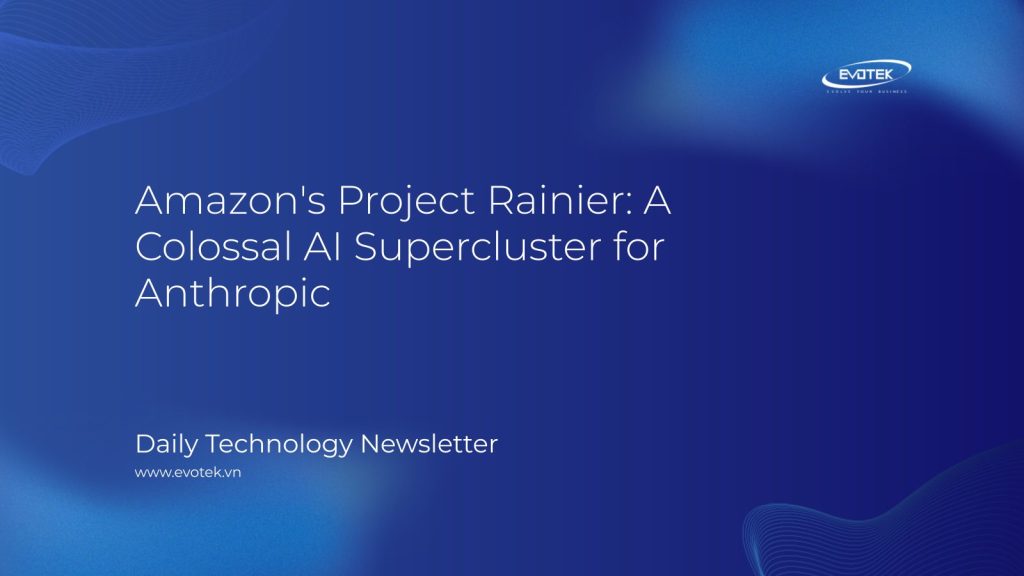Amazon Web Services (AWS) is forging ahead in the AI landscape with Project Rainier, a massive supercomputing cluster designed to empower Anthropic, its AI model-building partner. This ambitious project aims to provide Anthropic with a significant competitive edge in the rapidly evolving AI arena.
Unveiling Project Rainier: Scale and Scope
Project Rainier, slated to launch later this year, will boast “hundreds of thousands” of accelerators distributed across multiple US sites. One site in Indiana, as revealed by Gadi Hutt of Amazon’s Annapurna Labs, will encompass thirty 200,000-square-foot datacenters, consuming a staggering 2.2 gigawatts of power.
Unlike other AI supercomputers like OpenAI’s Stargate, xAI’s Colossus, or AWS’s Project Ceiba, Project Rainier leverages Amazon’s Annapurna AI silicon instead of GPUs. According to Hutt, this marks the first time Amazon is constructing such a large-scale training cluster, enabling Anthropic to train a single model across this expansive infrastructure.
Amazon’s commitment to Anthropic is substantial, with an existing investment of $8 billion in the OpenAI competitor.
Project Rainier: Key Features and Architecture
While Amazon remains tight-lipped about the project’s full scope, Anthropic has already gained access to a portion of its compute resources.
Trainium2: The Core of Rainier
At the heart of Project Rainier lies the Trainium2 accelerator from Annapurna Labs. Despite its name, Trainium2 supports both training and inference workloads, making it suitable for reinforcement learning (RL) applications.
Each Trainium2 accelerator comprises two 5nm compute dies, coupled with four high-bandwidth memory (HBM) stacks, delivering 1.3 petaFLOPS of dense FP8 performance, 96GB of HBM, and 2.9TB/s of memory bandwidth.
Trn2 Instances: Building Blocks of the Cluster
AWS’s Trn2 instances, the minimum configuration for Trainium2, feature 16 accelerators. Hutt emphasizes the importance of “good throughput of training” and minimizing downtime when evaluating large clusters.
Each Trn2 cluster incorporates eight compute blades (each with two Trainium2s), managed by a pair of Intel x86 CPUs. Unlike the switched all-to-all topology found in Nvidia’s NVL72, Trn2 clusters employ a 4×4 2D torus using AWS’s NeuronLink v3 interconnect, providing 1TB/s of chip-to-chip bandwidth.
UltraServers: Scaling Compute
Four Trn2 systems can be combined using NeuronLink to form an UltraServer, expanding the compute domain to 64 chips in a 3D torus configuration. Each accelerator in the cluster is equipped with 200Gbps of network bandwidth via Annapurna’s Nitro data processing units.
Amazon’s custom EFAv3 network is designed to deliver tens of petabits of bandwidth with sub-10-microsecond latency across the network.
Project Rainier: Scale and Power
Amazon aims to achieve a massive scale with Project Rainier, potentially reaching hundreds of thousands of Trainium2 chips. While the exact number remains undisclosed, even 10,000 UltraServers would equate to 640,000 accelerators.
Assuming a power consumption of approximately 500 watts per chip, a cluster of 256,000 Trainium2 accelerators could require between 250 and 300 megawatts of power.
Future Possibilities: Trainium3 and Beyond
While Project Rainier is currently based on Trainium2, the upcoming third-generation accelerators, built on TSMC’s 3nm process, could potentially be integrated into the project.
The Annapurna Labs team has teased a 40% improvement in efficiency with Trainium3, along with a 4x performance increase compared to Trn2-based systems.
Conclusion
Project Rainier represents a significant investment by Amazon in AI infrastructure, showcasing the company’s commitment to supporting Anthropic and pushing the boundaries of AI model training. As the project progresses, further details about its scale, performance, and potential integration of future technologies will undoubtedly emerge.
Keywords: Amazon, AWS, Anthropic, AI, Supercomputer, Project Rainier, Trainium2, Trainium3, Machine Learning, Deep Learning, Cloud Computing

 日本語
日本語 한국어
한국어 Tiếng Việt
Tiếng Việt 简体中文
简体中文